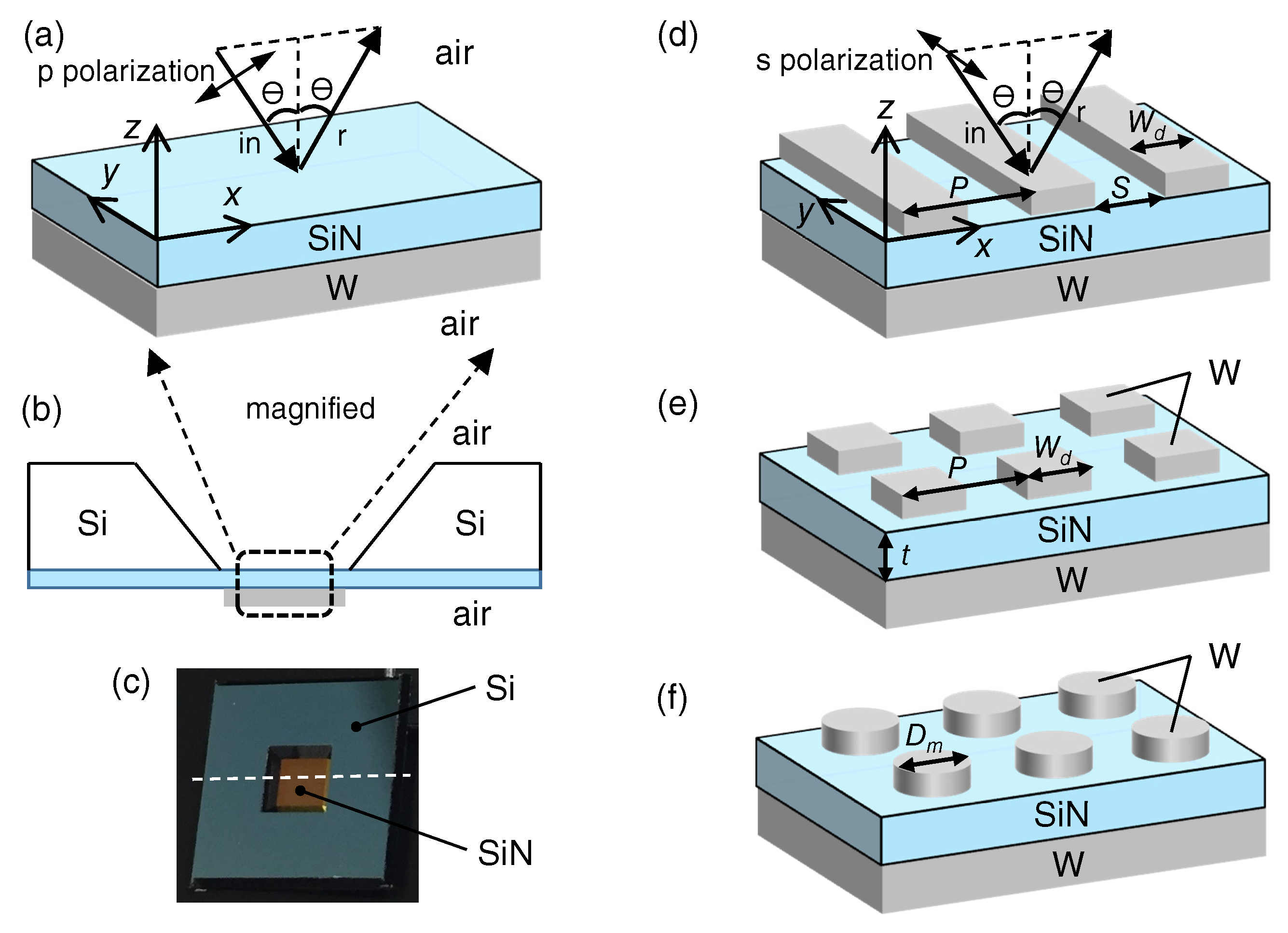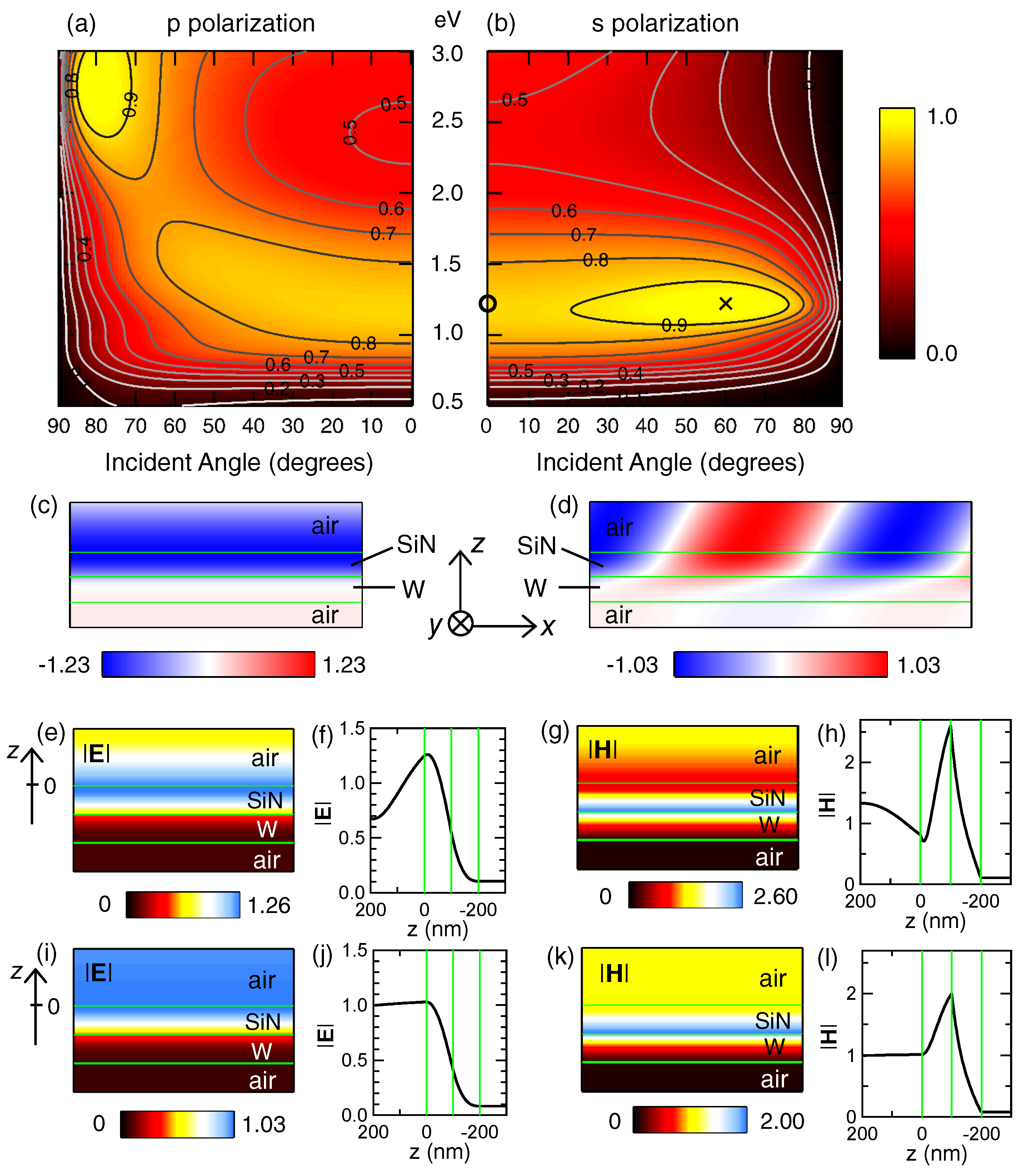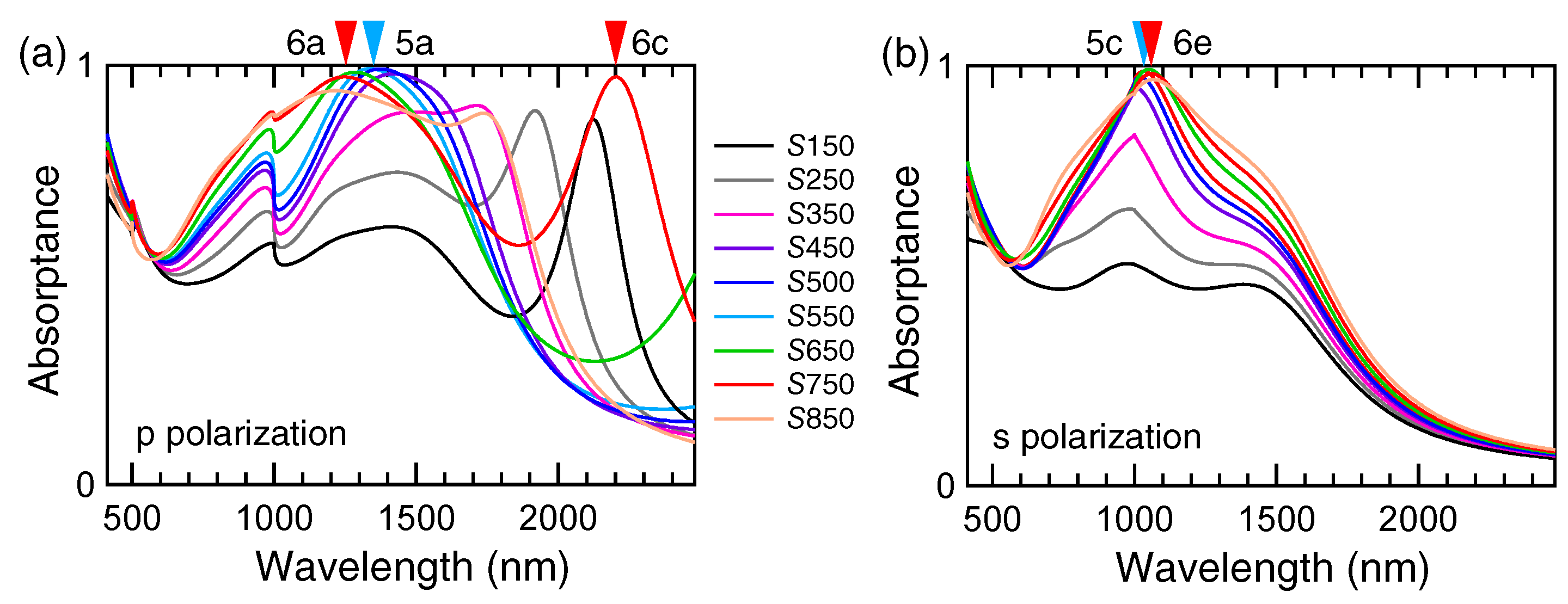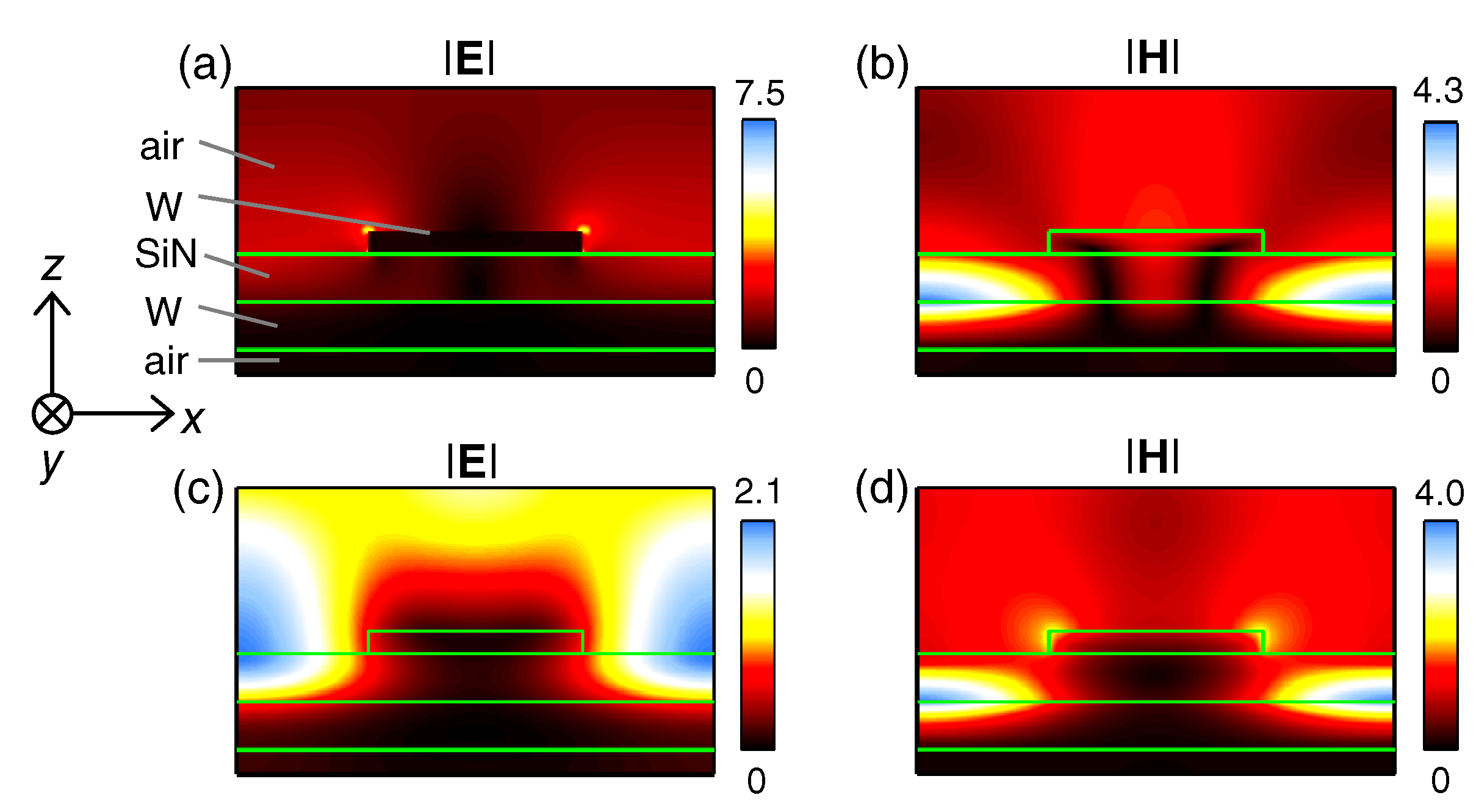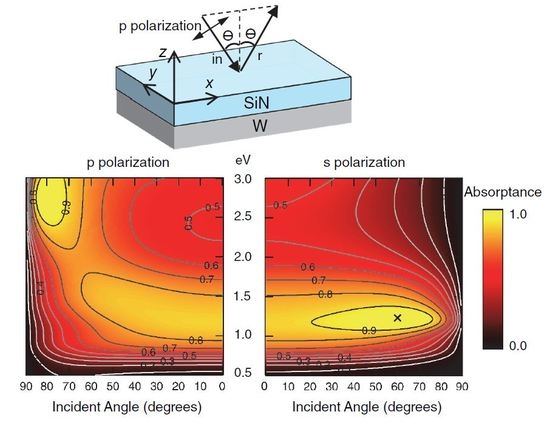1. Introduction
Membrane structures can be used to manipulate light in outstanding ways. One example is photonic crystals made of high-refractive index materials such as semiconductors [
1]. However, such membrane structures are generally fragile and difficult to handle since they are free-standing in air and have thickness less than the wavelength of light in vacuum, that is, subwavelength. Today, ceramic membranes can be realized, thanks to reliable thin-film fabrication techniques such as plasma-enhanced chemical vapor deposition. Here, we focus on membrane structures based on free-standing thin films made of ceramics. To make the application clear, we design perfect light absorbers (PLAs) suitable for thermal emitters in the short-wavelength infrared range of 1–2
m. Thermal emitters made of nanostructured materials are currently optimized for the mid-infrared range of 2–5
m, using metal-insulator-metal structures that typically comprise noble metals [
2,
3,
4,
5], aluminum [
6], etc., as constituent materials; however, these metals cannot withstand high temperatures.
A basic requirement exists for the thermal emitters, that is, high melting points exceeding 2000 K. From this point of view, we chose silicon nitride (SiN) as the ceramic and tungsten (W) as the metal in this study. Both of them are stable at high temperatures. Considering practical application, the thickness of SiN membranes and W are assumed to be 100–200 nm and 50–100 nm, respectively, which are usual values in commercial products [
7] and laboratory use. A 3D photonic crystal made of only W was once produced with a similar goal as mentioned above and worked as a thermal emitter at about 2
m [
8]. However, production of thermal emitters based on such structures still has a high demand and has not been standardized to date; thus, much simpler structures are highly preferred from the viewpoint of practical application.
Light absorbers in infrared ranges have a long history. Originally, the idea to obtain PLAs was simple; that is, to use materials as analogous to black bodies as possible. The absorbed infrared light has been converted to electric signals since the 1940s [
9]; the devices are well known as conventional bolometers. However, it has been difficult to attain PLAs over the whole wavelength range. Accordingly, PLAs based on the artificially designed structures were conceived for the particular wavelength ranges [
2,
3,
4,
5,
6]; in fact, the PLAs do not look like black bodies. Thus, there are distinct differences between black-body-based and artificial-structure-based PLAs.
Figure 1 illustrates schematics of W-SiN membrane structures studied in this work.
Figure 1a–c shows simply stacked W and SiN layers. The two-layer membrane structure is formed using a SiN membrane on a Si substrate. The section view is shown in
Figure 1b. The image of the original SiN membrane is shown in
Figure 1c; the central square domain of
mm
2 is the SiN membrane. Once deposition of W is performed, the W-SiN membrane structure in
Figure 1a,b is obtained. The white dashed line indicates a section corresponding to
Figure 1b.
Figure 1a also indicates the coordinate axes and optical configuration of p polarization, which is defined such that the incident polarization vector is parallel to the plane of incidence. Without loss of generality, we set the plane of incidence to be parallel to the
xz plane.
Figure 1d–f shows schematics of W-SiN-W membrane structures, whose top layers are set to be periodic.
Figure 1d also shows the coordinate axes and s polarization. When the plane of incidence is parallel to the
xz plane, s polarization means that the incident polarization is perpendicular to the
xz plane and parallel to the
y-axis.
Figure 1d shows a 1D periodic structure along the
x axis.
Figure 1e,f shows 2D periodic structures of square arrays of W patches; we set the coordinate axes to be similar to
Figure 1d. In
Figure 1d–f, we define notations
P,
S,
, and
for the periodic lengths, slit length, width of the W bars or square patches, and diameter of the circular W patches, respectively.
In the optical linear response regime, light absorptance
A is evaluated using the following equation:
where
and
denote the
mn-th reflective and transmissive diffraction, respectively.
and
are ordinary reflectance (R) and transmittance (T), respectively. As we describe in detail in
Section 3.2, the linear optical responses of
and
are directly computed in a numerically precise way, based on Maxwell equations. Note that Equation (
1) is represented in the
range where 0 and 1 denote 0% and 100%, respectively.
Perfect light absorption is related to perfect emittance by reciprocity [
10]; therefore, when thermal emitters were produced, researchers tried to attain perfect-absorption structures [
2,
3,
4,
5,
6]. Recently, nearly perfect absorption was observed in stacked complementary structures [
11], which show significant enhancement of electric-dipole emission loaded on the outmost surfaces [
12,
13,
14]. In addition, it was lately reported that high-emittance plasmonic cavities substantially enhance both electric- and magnetic-dipole emissions of Er ions [
15]. Thus, it has been quite common to relate efficient light absorption with high emittance.
In this study, we aim at designing PLAs made of a set of representative refractory metal and ceramic, based on precise numerical calculations. To propose realistic designs, we conduct the numerical calculations using reliable material parameters. As for the metal W, the complex relative permittivity is taken from the literature [
16], and, as for the ceramic SiN, we adopt a representative value, that is, permittivity of 4.3. Further details are provided in
Section 3.1. The representative value is sufficient to extract fundamental properties of the W–ceramic systems. We show that the W-SiN membranes are able to serve as PLAs even when they have subwavelength thickness, suggesting that they can function as low-power-consumption thermal emitters near the visible range. We also clarify that the working mechanism of the PLAs is unconventional, robust, and different from that of noble-metal–insulator systems studied so far [
2,
3,
4,
5,
6].
2. Results and Discussion
In this section, we show numerical results for PLAs made of W and SiN. Periodic structures are introduced to absorb incident light efficiently in the very thin membrane structures of subwavelength thickness. Below, we confirm the basic optical properties of the constituent materials.
Figure 2 shows the basic optical properties of W and SiN.
Figure 2a presents R and T spectra of W membrane with red solid and dashed lines, respectively. The W membrane is assumed to be free standing in air. The spectra are shown in the
scale. Note that the T spectrum is close to 0 in the whole wavelength range shown.
Figure 2a also shows R spectrum of bulk W of 1 mm thickness with blue curve, which is almost identical to the R spectrum of the W membrane. This means that the W membrane of 100 nm thickness is optically thick enough, being almost equivalent to bulk W in terms of the optical properties.
As for the spectral shapes of the W membrane in
Figure 2a, R decreases as the wavelength becomes shorter. For example, at 500 nm, R is 0.48 and, at 1000 nm, R is 0.58. In comparison with a noble metal Ag, the R values are quite small. This means that W is associated with substantially large optical loss even at the near-infrared range.
Figure 2b shows R and T spectra of SiN membranes of thickness
, 200, and 300 nm with red, green, and blue curves, respectively. The R and T spectra are shown with solid and dashed curves, respectively. The SiN membranes were assumed to be free-standing in air. The spectral shapes manifest the Fabry–Perot-type interference that is determined by the refractive index and thickness. Since we are assuming loss-less refractive index, light absorption does not take place at all in the SiN membranes.
2.1. Nearly PLA of Simply Stacked W-SiN Membrane
Figure 3 shows typical results on light absorption and electromagnetic (EM) fields in a simply stacked W-SiN membrane. The schematic is shown in
Figure 1a. We fix the thickness of the W and SiN layers to be 100 nm because we intend to elucidate representative properties of the two-layer membrane.
Figure 3a,b shows 2D color and contour plots of light absorptance under p and s polarizations, respectively. The horizontal and vertical axes represent incident angles and photon energy in eV, respectively. Note that the normal incidence of 0° is in common with the two polarizations. The absorptance was evaluated using Equation (
1). High absorptance of more than 0.8 (or 80%) appears both at p and s polarizations in the 1.0–1.5 eV (that is, 1239.5–826.3 nm in wavelength) range including the normal incidence. Perfect absorption also appears both at p and s polarizations; under p polarization, it is located around 78° and 2.8 eV, and, under s polarization, it is around 60° and 1.2 eV.
Figure 3a,b explicitly shows perfect absorption by the two-layer W-SiN membrane. Multilayers of noble metals and insulators have been studied since the 1960s [
17,
18]. Although several papers reported experimental observations of the optical responses [
19,
20,
21,
22,
23], perfect light absorption, to our best knowledge, has not been observed in the noble-metal–insulator multilayer membranes. Thus, the optical response of the two-layer W-SiN membrane turns out to be unconventional.
Figure 3c,d shows snapshots of electric-field distributions under conditions of large light absorption; each condition is indicated by open circle (∘) and cross (×), respectively, in
Figure 3b. The corresponding incident angles are
and
. Under both conditions, the incident polarization was s polarization; accordingly, the
component is plotted with blue-to-red colors in
Figure 3c,d. We set the incident
equal to 1.0. The incident light propagates from the top. The interfaces of air/SiN, SiN/W, and W/air are shown with green lines.
Figure 3e,f corresponds to
Figure 3c, and shows the absolute value of electric field
and the profile along the
z-axis, respectively. The green lines indicates the interfaces, similarly to
Figure 3c. We set the interface of air/SiN at
. Note that
Figure 3f is plotted in decreasing order on the horizontal axis. Obviously, the electric field rapidly decays inside the two-layer W-SiN membrane; in other words, it is efficiently absorbed in the membrane. From Equation (
1), perfect absorption (
) requires
, which is often called impedance matching. Under the open-circle condition in
Figure 3b, although the absorptance is not exactly equal to 1, the electric-field distribution is qualitatively understood to be due to impedance matching and does not arise from a plasmonic resonance.
Figure 3g,h corresponds to
Figure 3e,f, and shows the absolute value of magnetic field
and the profile along the
z axis, respectively. The
profile takes the maximum value at the W/SiN interface. We mention that the magnetic-field distribution is uniquely determined by the boundary-connection conditions in the membrane structure and that light absorption mostly takes place in the W layer through one of Maxwell equation,
where
is permittivity in vacuum because spatial distribution of
is directly affected by the complex relative permittivity in the W layer (
); the permittivity
has a large imaginary part [
16] that is associated with optical loss.
Figure 3i,j corresponds to
Figure 3d and shows the
distributions in a similar way to
Figure 3e,f. Also under the oblique incidence (× in
Figure 3b), the
profile indicates efficient light absorption.
Figure 3k,l corresponds to
Figure 3i,j, and shows the
distribution and the
z profile, respectively. Qualitatively, the descriptions for
Figure 3g,h are true for
Figure 3k,l as well.
In short, the large light absorption at 1.0–1.5 eV and wide incident angles including
is ascribed to impedance matching of the two-layer membrane structure. The efficient absorption primarily originates from the property of W permittivity. We point out that the single layer of W does not realize efficient light absorption as shown in
Figure 2a. In this sense, the two-layer membrane structure is the minimal requirement for large light absorption in W–ceramic systems.
2.2. 1D Periodic PLAs Made of W-SiN-W Membranes
Figure 4 shows absorptance spectra of on-top 1D periodic W-SiN-W membranes. The schematic is shown in
Figure 1d. We set the periodicity
P to be 1000 nm and the incidence was set to be normal; we found signatures of diffraction at 1000 nm such as small steps in
Figure 4a and kinks in
Figure 4b. Various absorptance spectra represent light absorption in the 1D periodic W-SiN-W membranes with different widths of air slit
S, which was varied from 150 to 850 nm. Accordingly, the width of metal,
, was varied from 850 to 150 nm because
. The linear optical responses (
and
) were numerically computed and the absorptance was evaluated using Equation (
1).
As
S increases under p polarization in
Figure 4a, the absorptance spectra for
(purple curve) to 750 nm (red curve) have perfect-absorption peaks around 1300 nm. For
nm, another nearly perfect-absorption peak appears at 2200 nm, whose signature is seen for
nm (green curve) at the longest wavelength edge.
As
S increases under s polarization in
Figure 4b, the absorptance gradually increases and reaches almost 1 for
nm (blue curve), and keeps the perfect absorption at approximately 1050 nm for larger
S.
Color cones in
Figure 4 indicate some of the perfect-absorption peaks for which we next examine the EM fields. Symbols such as 5a and 6a associated with the color cones denote the corresponding EM distributions shown in
Figure 5a and
Figure 6a, respectively.
Figure 5 presents EM-field distributions at perfect-light-absorption conditions of 1D W-SiN-W membranes with air slit
nm and width of the metal
nm. The incidence conditions of polarization and wavelength are indicated in
Figure 4 with the sky-blue cones. The absolute values
and
are shown in linear scale in the minimum-to-maximum-value manners.
Figure 5a,b shows an
xz-section view of
and
distributions under the incidence condition indicated by the sky-blue cone in
Figure 4a (p polarization and 1350.2 nm). The incidence was normal, being normalized such that the incident
and
. The boundaries of the involved materials are shown with green lines, except for the air/W boundary in
Figure 5a because of the high contrast and to avoid concealing small hot spots by the lines. The electric field is locally amplified at the W corners, exhibiting the small hot spots, whereas the magnetic field is localized at the flat SiN/W interface. The
profile is quite similar to the two-layer system in
Figure 3. We point out that the so-called gap mode in the W-SiN-W structure is not responsible for the perfect absorption.
Figure 5c,d shows the
and
distributions in the
xz section under another perfect-absorption condition, indicated by the sky-blue cone in
Figure 4b (s polarization and 1032.1 nm). Then, the incident polarization vector is parallel to the
y-axis and satisfies
; accordingly, the incident
.
Figure 5c shows that there is no hot spot and the electric field reaches the bottom W layer unless the top W bar interrupts the propagation.
Figure 5d shows that the magnetic field is mainly enhanced at the flat SiN/W interface, similarly to
Figure 5b. Thus, in this 1D periodic system of
nm, the perfect absorption takes place with a mechanism similar to that in the two-layer membrane structure. It is to be stressed that, even though the structure is certainly anisotropic in the 1D periodic W-SiN-W membrane, the perfect-absorption mechanism is primarily independent of the incident polarizations and the structural anisotropy.
Figure 6 displays EM-field distributions at perfect-light-absorption conditions of 1D W-SiN-W membranes with air slit
nm and width of the metal
nm. The corresponding absorptance spectra are shown with the red curves in
Figure 4 and the three nearly perfect-absorption peaks are indicated by the red cones. Green lines indicate the boundaries of the 1D periodic membrane, similarly to
Figure 5.
Figure 6a,b shows the
and
distributions, respectively, under p polarization and 1252.0 nm. The EM-field distributions are qualitatively similar to those in
Figure 5a,b, irrespective of the substantial difference in air slit
S.
Figure 6c,d shows the
and
distributions, respectively, under the condition of p polarization and 2201.6 nm, which correspond to nearly perfect absorption sensitive to
S. We note that only the scale in
Figure 6c is shown in a peak-cut way; that is, although the maximum value of
in
Figure 6c is 64, the scale is set to have the maximum at 30 and the locations exceeding 30 are represented in sky blue. Qualitatively, the EM-field distributions are distinct from those in
Figure 6a. The electric- and magnetic fields show strong localization around the W-SiN-W gap. It is obvious that the
distribution takes the maximum value in the gap. These EM-field distributions are peculiar to the gap mode or plasmonic waveguide mode [
12]. Thus, it is found that the plasmonic gap mode appears at a particular condition, being sensitive to the structural parameters.
Figure 6e,f shows the
and
distributions, respectively, under s polarization and 1060.2 nm. The EM-field distributions are quite similar to those in
Figure 5c,d, strongly suggesting that the perfect absorption owing to the impedance matching is quite robust to the structural modifications.
2.3. 2D Periodic PLAs Made of W-SiN-W Membranes
Figure 7a,b shows absorptance spectra of 2D periodic W-SiN-W membranes of on-top rectangular and circular patches, respectively. The schematics are shown in
Figure 1e,f. Each panel in
Figure 7 presents two spectra for the 2D periodic membranes with periodicity
nm and the middle SiN-layer thickness
and 200 nm, which are shown with black and green curves, respectively. One side of the W square was set to
nm and the diameter of the circular W was
nm, where
was chosen to keep the volume of the circular patch equivalent to that of the square one. The thickness of the top and bottom layers of W was set to 50 and 100 nm, respectively. Quantitatively, they exhibit similar absorptance spectra, irrespective of the difference of the patch shapes.
One common feature in
Figure 7a,b is that perfect-absorption bands appear at 1050–1200 nm. We note that, in the 1D periodic membranes in
Figure 4, the perfect absorption appears as peaks (not band). This feature is due to the 2D periodic structures and probably originate from the dimensionality. The cone at 1126.8 nm in
Figure 7a indicates the wavelength corresponding to EM-field distributions in the next Figure.
Figure 8 shows a set of EM-field distributions of the 2D periodic W-SiN-W membrane at a perfect-absorption condition indicated by the cone (1126.8 nm) in
Figure 7a. The incidence was set to be normal and to have
and
. Note that the scales for
and
are in common to provide systematic views. Green lines indicate the boundaries in the 2D membrane.
Figure 8a,b shows the
and
distributions, respectively, in a
xz section that cut through the center of the on-top square W patch. The incident polarization vector
is parallel to the
x-axis and induces hot spots at the corner of the W patch. The
distribution takes larger values than the incidence at the interfaces of air/W and SiN/W.
Figure 8c,d shows the corresponding
yz-section view through the center of the on-top square W patch. The
distribution does not include any hot spot whereas the
distribution is strongly localized at the SiN/W interface, being scattered at the corner of the on-top W patch.
Figure 8e displays an
xy-view
distribution at a representative
z position, which was set to be 1 nm above the air/W interface and indicated by the cones in
Figure 8a,c. The position of the square W patch is shown with green lines for better visibility. The
distribution takes the maximum value at the corners of the W patch and mainly localizes around the W patch.
Figure 8f shows an
xy-view
distribution at a representative
z position, which was set to be 1 nm above the interface of the SiN/W and indicated by the cones in
Figure 8b,d. The
distribution is mostly enhanced at the positions between the on-top W patches and localizes at the SiN/W interface. Thus, it is found that the perfect-absorption band is realized by the combination of local electric-field scattering by the on-top W patch and magnetic-field localization at the SiN-W interfaces. The local scattering can be interpreted as local plasmon at the rectangular W nanostructures and includes substantial longitudinal components that are usually excited as continuum [
12] and are considered to realize the perfect-absorption continuum. In terms of the structures, the 1D structures in
Figure 4 do not have the rectangular corners in the
xy plane and therefore do not tend to form perfect-absorption continuum.
